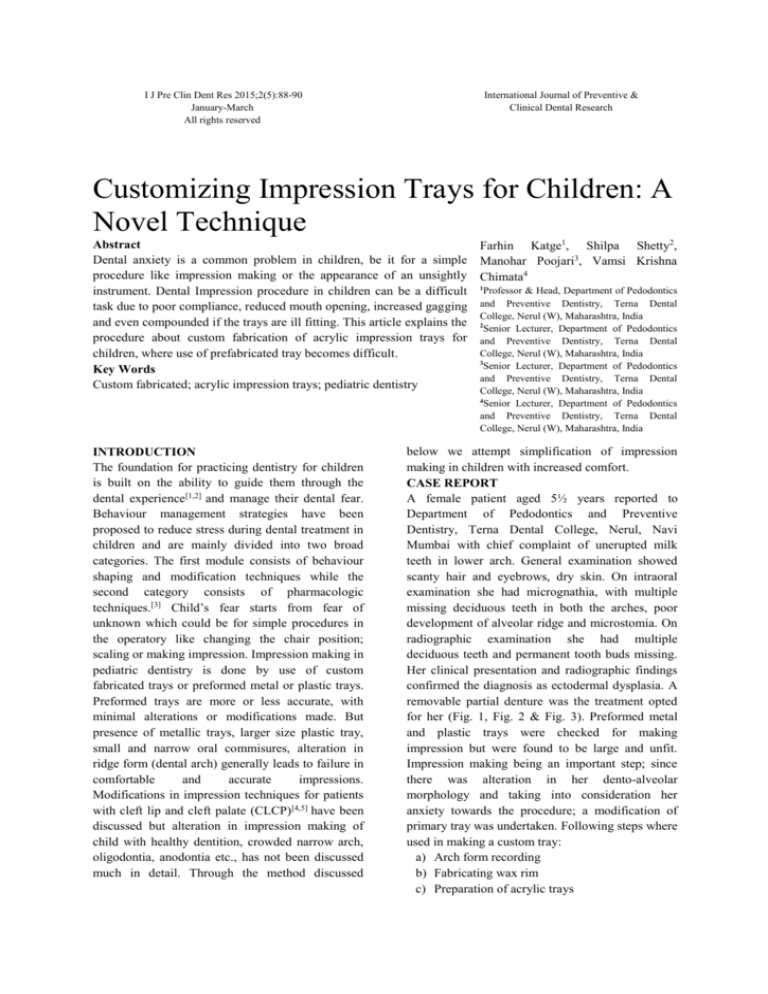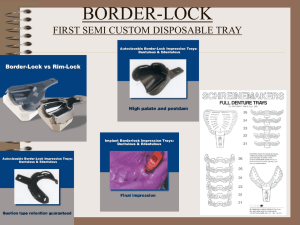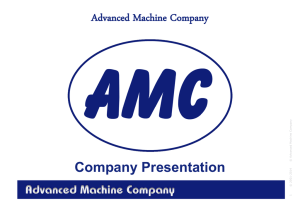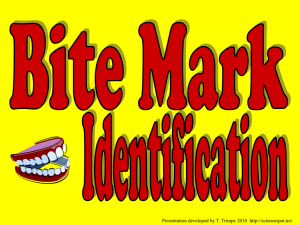
I J Pre Clin Dent Res 2015;2(5):88-90
January-March
All rights reserved
International Journal of Preventive &
Clinical Dental Research
Customizing Impression Trays for Children: A
Novel Technique
Abstract
Dental anxiety is a common problem in children, be it for a simple
procedure like impression making or the appearance of an unsightly
instrument. Dental Impression procedure in children can be a difficult
task due to poor compliance, reduced mouth opening, increased gagging
and even compounded if the trays are ill fitting. This article explains the
procedure about custom fabrication of acrylic impression trays for
children, where use of prefabricated tray becomes difficult.
Key Words
Custom fabricated; acrylic impression trays; pediatric dentistry
INTRODUCTION
The foundation for practicing dentistry for children
is built on the ability to guide them through the
dental experience[1,2] and manage their dental fear.
Behaviour management strategies have been
proposed to reduce stress during dental treatment in
children and are mainly divided into two broad
categories. The first module consists of behaviour
shaping and modification techniques while the
second category consists of pharmacologic
techniques.[3] Child’s fear starts from fear of
unknown which could be for simple procedures in
the operatory like changing the chair position;
scaling or making impression. Impression making in
pediatric dentistry is done by use of custom
fabricated trays or preformed metal or plastic trays.
Preformed trays are more or less accurate, with
minimal alterations or modifications made. But
presence of metallic trays, larger size plastic tray,
small and narrow oral commisures, alteration in
ridge form (dental arch) generally leads to failure in
comfortable
and
accurate
impressions.
Modifications in impression techniques for patients
with cleft lip and cleft palate (CLCP)[4,5] have been
discussed but alteration in impression making of
child with healthy dentition, crowded narrow arch,
oligodontia, anodontia etc., has not been discussed
much in detail. Through the method discussed
Farhin Katge1, Shilpa Shetty2,
Manohar Poojari3, Vamsi Krishna
Chimata4
1
Professor & Head, Department of Pedodontics
and Preventive Dentistry, Terna Dental
College, Nerul (W), Maharashtra, India
2
Senior Lecturer, Department of Pedodontics
and Preventive Dentistry, Terna Dental
College, Nerul (W), Maharashtra, India
3
Senior Lecturer, Department of Pedodontics
and Preventive Dentistry, Terna Dental
College, Nerul (W), Maharashtra, India
4
Senior Lecturer, Department of Pedodontics
and Preventive Dentistry, Terna Dental
College, Nerul (W), Maharashtra, India
below we attempt simplification of impression
making in children with increased comfort.
CASE REPORT
A female patient aged 5½ years reported to
Department of Pedodontics and Preventive
Dentistry, Terna Dental College, Nerul, Navi
Mumbai with chief complaint of unerupted milk
teeth in lower arch. General examination showed
scanty hair and eyebrows, dry skin. On intraoral
examination she had micrognathia, with multiple
missing deciduous teeth in both the arches, poor
development of alveolar ridge and microstomia. On
radiographic examination she had multiple
deciduous teeth and permanent tooth buds missing.
Her clinical presentation and radiographic findings
confirmed the diagnosis as ectodermal dysplasia. A
removable partial denture was the treatment opted
for her (Fig. 1, Fig. 2 & Fig. 3). Preformed metal
and plastic trays were checked for making
impression but were found to be large and unfit.
Impression making being an important step; since
there was alteration in her dento-alveolar
morphology and taking into consideration her
anxiety towards the procedure; a modification of
primary tray was undertaken. Following steps where
used in making a custom tray:
a) Arch form recording
b) Fabricating wax rim
c) Preparation of acrylic trays
89
Customizing impression trays
Fig. 1: Front intra oral view and cross bite
Katge F, Shetty S, Poojari M, Chimata VK
Fig. 2: Maxillary and Mandibular occlusal view
Fig. 3: Orthopantomograph
Fig. 4: Arch form recording
Fig. 5: Wax templates
Fig. 6: Impression trays constructed
Fig. 7: Upper and lower impressions
d) Border lining with wax
STEP I
Recording Arch form
Classification of arch form recording techniques
Anodontia/oligodontia
Dentulous
Wax template
Wax sheet (moulding)
Impression compound
Bite registration (with
moulding
wax)
The present case had hypodontia with 73 to 83 and
52,62 missing. Method used to record arch form
was using a wax template. A modeling wax sheet in
shape of U was used as a template to record
tentative dimensions and shape of arch (Fig. 4).
For Other Clinical Conditions
Bite registration
Modeling wax sheet strip or alu wax is softened and
moulded as per the arch shape with extension till the
last erupted lower molar and ask the patient to bite.
Spray water with three-way syringe to reduce
alteration of arch form during removal.
Wax sheet (Moulding)
A wax strip measuring 1cm x 6cms was thermally
softened and adapted over the dental arch,
extending up to the vestibular depth.
Impression compoundUsed in edentulous arches where thermally softened
impression compound is moulded to the tentative
shape of the arch.
STEP II
Once wax template is made, it acts as a guide over
which wax rims of height and width approximately
3-5 mm are prepared (Fig. 5).
STEP III
Acrylic tray is prepared over wax rim using salt &
pepper or dough method .In maxillary tray the
90
Customizing impression trays
palatal extension is removed giving it horseshoe
shape appearance. This design would assist excess
impression material mixed at right consistency to
flow and record the palatal vault area, thus avoiding
posterior extension and gag reflex.
STEP IV
Checking for adequate thickness of acrylic tray.
STEP V
Removal of wax from the acrylic tray.
STEP VI
Clean, trim, sand paper the trays. Prepare vents for
flow of excess material. Line the trays with wax, to
avoid any sharp edges (Fig. 6). This customization
of trays improves patient comfort and acceptability
(Fig. 7).
DISCUSSION
Impression procedures in children pose a unique set
of challenges and are often difficult to use
conventional methods for fabricating dentures.[5,6]
Hence, factors influencing alterations in primary
tray for impression technique:
a) Less mouth opening / Small oral commisure
b) Small arch form (in infants)
c) Behaviour aspects
d) Fear to metal objects / Fear of unknown
e) Difficulty in understanding / cooperation
f) Alterations in arch form
g) Sensitivity of mucosa (to sharp objects)
h) Manufacturer’s defect
CONCLUSION
Modifications and alterations should be adapted and
practiced when the need arises in patients in whom
preformed trays are deemed to be unfit. Accuracy
from step one leads to better results and this present
method proposes an alteration in basic steps for
comfort, ease and as a add on towards perfection in
clinical dentistry.
Why this paper is important to paediatric dentists
1. Modifying impression techniques to suit the
arch form.
2. Acceptable by children as the sizes of the trays
are customised.
3. Can be useful in cleft patients, anodontia,
ectodermal dysplasia, reduced mouth opening.
REFERENCES
1. Suprabha BS, Rao A, Choudhray S, Shenoy R.
Child dental fear and behavior: the role of
environmental factors in a hospital cohort. J
Indian Soc Pedod Prev Dent 2011;29(2):95101.
2. Elango I, Baweja DK, Shiva Prakash PK.
Parental acceptance of pediatric behavior
Katge F, Shetty S, Poojari M, Chimata VK
3.
4.
5.
6.
management techniques. A comparative study.
J Indian Soc Pedod Prev Dent 2012;30(3):195200.
Salem K, Kousha M, Anissian A, Shahabi A.
Dental fear and concomitant factors in 3-6
year old children. J Dent Res Dent Clin Dent
Prospects 2012;6(2):70-4.
Pani SC, Hedge AM. Impressions in cleft lip
and palate – A novel two stage technique. J
Clin Pediatr Dent 2008;33(2):93-6.
Bachhav VC, Aras MA. A simple method for
fabricating custom sectional impression trays
for making definitive impressions in patients
with microstomia. Eur J Dent 2012;6(3):244-7.
Ravichandra KS, Vijayaprasad KE, Vasa
AAK, Suzan S. A new technique of
impression making for an obturator in cleft lip
and palate patient. J Indian Soc Pedod Prev
Dent 2010;28(4):311-4.









